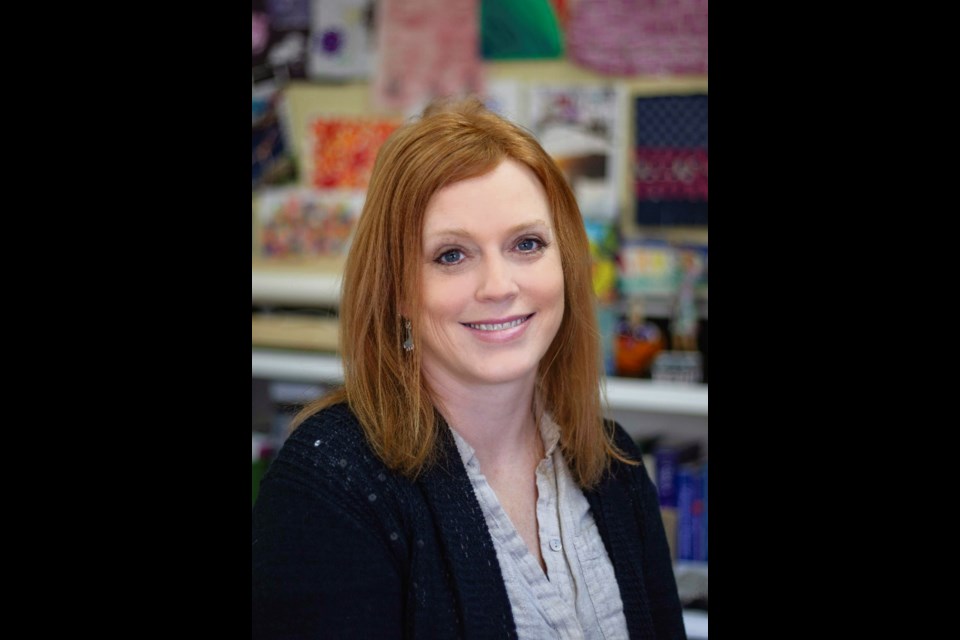Art lets us beautify our environment and express ourselves creatively. But it’s much more than that for Joanna Watt.
The art therapist is based in Reston and works with clients all across southwestern Manitoba. In November, her own “therapeutic interventions” were on display at the Arts Mosaic gallery in Virden.
Meet art therapist Joanna Watt:
Q: What is art therapy?
A: Art therapy is a form of psychotherapy that allows for the expression of feelings, both verbal and non-verbal. There is no need for artistic talent. Together, the client and therapist journey through the healing process by using mindfulness, breathing and grounding techniques, painting, drawing, collage, clay, textiles, music, movement, writing, books, and play. Art therapy is an excellent way to explore the self, work on emotional regulation and create an overall sense of wellbeing.
Q: How is art therapy different from a regular art class in school?
A: While being creative in any way can help reduce tension and provide a sense of relief, art classes focus on technique and finished product. Art therapy is about giving space to the feelings and emotions that we carry. This allows us to create something tactile, so we can step back from the emotional charge and look at the situation from an observer’s stance. Not all feelings have words, especially in children or adults who were harmed as children. Art therapy allows for people to resolve their feelings in a non-threatening, non-retraumatizing way.
Q: Can you give an example of a situation where it would be useful?
A: Art therapy has been found helpful to those with addictions, trauma, boundary violations, eating disorders, anxiety, chronic pain, depression, loss of self, grief, anger management, impulse control, over-thinking, self-regulation, and so on.
Q: You also do bibliotherapy, what is that?
A: We have all read a book that changed our way of thinking. Bibliotherapy is the utilization of the written word to help us think in different ways. For children, this can be especially helpful. Stories can help by simplifying big concepts into age-appropriate messages. We can also write stories that help us work through the topics that distress us.
Q: Can you give an example of a specific book and how it can help a child?
A: “The Don’t Worry Book” by Todd Parr is an excellent book for children aged 2-5 about worries. Little people have big worries. Leaving home for the first time is a big worry. Through stories we can help normalize these big feelings.
Q: Who are your clients? Who can access your services?
A: Clients come from all backgrounds and ages, with all types of abilities and needs. Art therapy is currently not available through Manitoba Health, so clients are self-pay. Hopefully, as awareness grows of this therapeutic model, it will become more accessible. Private sessions are available for families and individuals. Group sessions are available for organizations and individuals who do well in a group therapy setting or need to reduce therapy costs.
In partnership with Arts Mosaic and Pipestone-Albert Recreation, we have created the “Rural Youth Arts Circle” after-school program for ages 8-13. The program currently runs in Virden and Reston, and the focus of this program is to provide our young community members with a safe space to find their voice, normalize common problems like social anxiety and fears, establish authenticity as an individual, and learn to incorporate creativity into a healthy lifestyle.
Q: Why did you start Pipestone Art Therapy?
A: I started my private practice because art therapy should be accessible to everyone. Not everyone likes to talk and not everything has words. Living rurally, I recognize the limited access to services and the need for people to have a place where they feel safe, non-judged, and can do work necessary for a healthy life. There was a need in southwestern rural Manitoba, so I filled it.
Q: Can you tell me about your background and how it led you to this work?
A: After immigrating to Canada (from the US), I was fortunate to find work in rural mental health. One day while researching how to better help my clients, I came across art therapy. The WHEAT Institute in Winnipeg offers a post-baccalaureate diploma in Art Therapy and a program I could manage while continuing to work, volunteer, and be a mother and wife. Art therapy trains differently than other psychology programs. Students are subject to being the center of the therapeutic lesson for others. So not only do you learn how to provide therapeutic models, you process your own issues to become more self-aware and present. It was powerful! It refocused me as a person and provided me the tools to help others refocus safely. It was something I could not only practice for myself, but utilize for others in the rural setting.
Pipestone Art Therapy can be found on Instagram, Facebook and at www.pipestonearttherapy.com.




